
Diplotropis is a genus of trees. It includes ten species native to northern South America, ranging from Colombia and Venezuela to Bolivia and west-central and southeastern Brazil.

Myrocarpus is a genus of flowering plants in the family Fabaceae. It includes five species of trees native to tropical South America, ranging from Venezuela to northern Argentina. Typical habitats include wet to seasonally-dry tropical lowland forest and woodland.
Neoharmsia is a genus of legume in the family Fabaceae. It includes two species of trees or shrubs endemic to Madagascar. Typical habitats are seasonally-dry tropical woodland and succulent thicket or woodland, on limestone or coastal sand, in the northern and western parts of the island.

Pericopsis is a genus of flowering plants in the legume family, Fabaceae. It includes four species of trees and shrubs, three native to sub-Saharan Africa and one to Sri Lanka, Malesia, New Guinea, and the Caroline Islands. Typical habitats include tropical lowland forest and seasonally-dry woodland and wooded grassland.
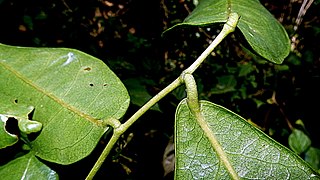
Poecilanthe is a genus of flowering plants in the family Fabaceae. It includes 9 species of trees and shrubs native to eastern, southern, and west-central Brazil, Bolivia, Paraguay, Uruguay, and northeastern Argentina. They grow in seasonally-dry tropical forest, woodland, thicket, and riverine forest.
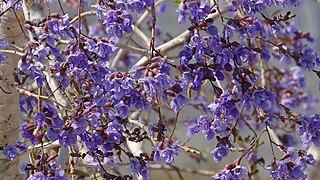
Bowdichia is a genus of flowering plants in the legume family, Fabaceae. It belongs to the subfamily Faboideae. The genus includes two species native to tropical South America and Costa Rica.
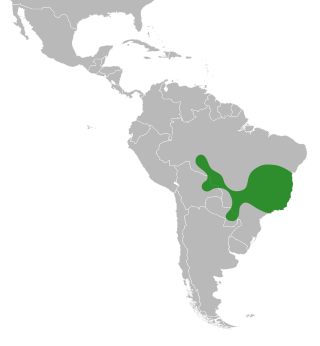
Cyclolobium brasiliense is a species of flowering plants in the legume family, Fabaceae. It belongs to the subfamily Faboideae. It is native to Bolivia, Brazil, and Paraguay and is the only member of the genus Cyclolobium.
Gonocytisus is a genus of flowering plants in the family Fabaceae. It belongs to the subfamily Faboideae. It includes three species of shrubs native to the eastern Mediterranean, ranging from Greece through Turkey and the levant. They grow in lowland and submontane Mediterranean woodland and shrubland (maquis), where they are often found on cliffs and dry hillsides.
Grazielodendron riodocensis is a species of flowering plant in the legume family, Fabaceae. It belongs to the subfamily Faboideae, and was recently assigned to the informal monophyletic Pterocarpus clade within the Dalbergieae. It is the only member of the genus Grazielodendron. It is only found in eastern Brazil.
Harleyodendron unifoliolatum is a species of flowering plant in the legume family, Fabaceae. It belongs to the subfamily Faboideae. It is the only member of the genus Harleyodendron. It is a tree endemic to northeastern Brazil.

Holocalyx balansae is a species of flowering plant in the legume family, Fabaceae. It belongs to the subfamily Faboideae. It is the only member of the genus Holocalyx. It is a tree native to South America, where it ranges from eastern, southern, and west-central Brazil to Bolivia, Paraguay, and northeastern Argentina.

Plagiocarpus is a genus of flowering plants in the legume family, Fabaceae. It includes seven species of shrubs or subshrubs native to northern Australia, from the Kimberley region of Western Australia to western Queensland. Their habitats include seasonally-dry tropical to subtropical woodland, bushland and thicket, shrubland, and grassland, typically on sandstone or sandy soils. It belongs to the subfamily Faboideae.
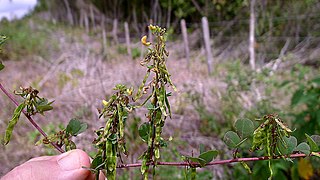
Poiretia is a genus of flowering plants in the legume family, Fabaceae. It includes 12 species of twining, scandent, or erect herbs and shrubs native to the tropical Americas, ranging from southern Mexico to northern Argentina, including Cuba and Hispaniola. Most species are native to eastern Brazil, Paraguay, and northern Argentina; Poiretia punctata ranges further north and west to northern South America, Central America, Mexico, and the Caribbean. Typical habitats include seasonally-dry tropical to subtropical riverine forest, woodland (cerrado), grassland, and shrubland.
Riedeliella is a genus of flowering plants in the legume family, Fabaceae. It includes three species of scandent shrubs native to Paraguay and eastern and west-central Brazil. They grow in seasonally-dry tropical forest, cerrado, and caatinga. The genus belongs to the subfamily Faboideae, and was recently assigned to the informal monophyletic Pterocarpus clade within the Dalbergieae.
Soemmeringia semperflorens is a species of flowering plants in the legume family, Fabaceae. It is the only member of the genus Soemmeringia.
Sweetia fruticosa is a species of flowering plants in the legume family, Fabaceae. It is a tree native to eastern, southern, and west-central Brazil, Bolivia, Paraguay, and northeastern Argentina. It is the only member of the genus Sweetia. It belongs to the subfamily Faboideae. It was traditionally assigned to the tribe Sophoreae, mainly on the basis of flower morphology; recent molecular phylogenetic analyses assigned Sweetia fruticosa into an informal, monophyletic clade called the "vataireoids".
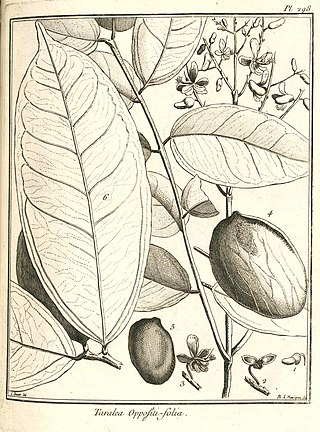
Taralea is a genus of flowering plants in the family Fabaceae. It includes five species of trees and shrubs native to northern South America, ranging from Colombia and Peru to Venezuela, the Guianas, and northern and northeastern Brazil. Habitats include riverine and inundated tropical lowland rain forest, seasonally dry forest, woodland, and marsh. One or two species are also found in montane forest and in open moist woodland and scrub on sandstone-derived soils. It belongs to subfamily Faboideae.
Uleanthus erythrinoides is a species of flowering plant in the family Fabaceae. It is a tree native to northern Brazil. It is the only member of the genus Uleanthus. It belongs to the subfamily Faboideae.

Vatairea is a genus of flowering plants in the legume family, Fabaceae. It includes eight species of tall trees native to the tropical Americas, ranging from southern Mexico to Bolivia and southern Brazil. Seven species are native to northern South America, with the center of diversity in Amazonia. Vatairea lundellii ranges from southern Mexico to Panama. Most species grow in tropical rain forest, often in the inudated forests known as igapó and varzea, where they are emergent trees, growing above the forest canopy. V. macrocarpa grows in seasonally-dry forest, cerrado, and caatinga.

Pterodon is a genus of flowering plants in the legume family, Fabaceae. It includes four species of trees native to Brazil and Bolivia. Typical habitats include seasonally-dry tropical forest, woodland (cerrado), and thorn shrubland (caatinga), often on rocky outcrops. It belongs to the subfamily Faboideae.












